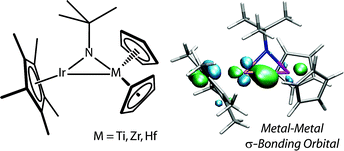Preparation and physical properties of early-late heterobimetallic compounds featuring Ir–M bonds (M = Ti, Zr, Hf)†
Abstract
Treatment of Cp*Ir NtBu (1) with the appropriate

* Corresponding authors
a
691 Tan Hall, Department of Chemistry, University of California, Berkeley, CA, USA
E-mail:
rbergman@berkeley.edu
Fax: +1-510-642-7714
Tel: +1-510-642-2156
b
591 Tan Hall, Department of Chemistry, University of California, Berkeley, CA, USA
E-mail:
tdtilley@berkeley.edu
Fax: +1-510-642-8940
Tel: +1-510-642-8939
Treatment of Cp*Ir NtBu (1) with the appropriate

 Please wait while we load your content...
Something went wrong. Try again?
Please wait while we load your content...
Something went wrong. Try again?
J. J. Curley, R. G. Bergman and T. D. Tilley, Dalton Trans., 2012, 41, 192 DOI: 10.1039/C1DT11753J
To request permission to reproduce material from this article, please go to the Copyright Clearance Center request page.
If you are an author contributing to an RSC publication, you do not need to request permission provided correct acknowledgement is given.
If you are the author of this article, you do not need to request permission to reproduce figures and diagrams provided correct acknowledgement is given. If you want to reproduce the whole article in a third-party publication (excluding your thesis/dissertation for which permission is not required) please go to the Copyright Clearance Center request page.
Read more about how to correctly acknowledge RSC content.
 Fetching data from CrossRef.
Fetching data from CrossRef.
This may take some time to load.
Loading related content
